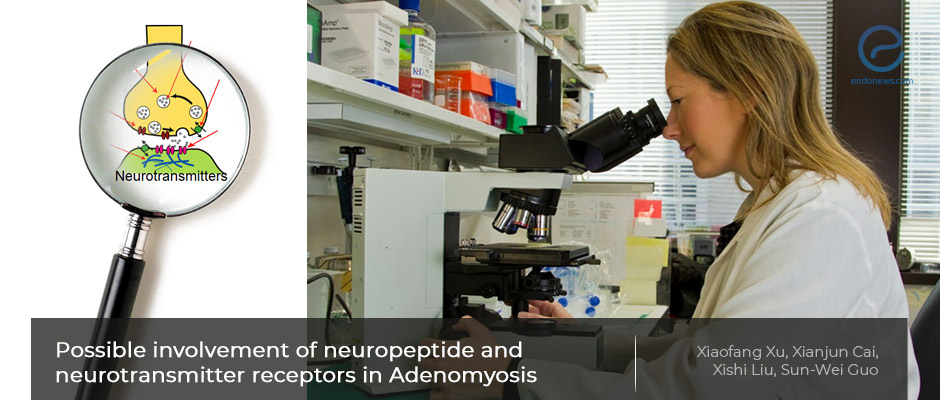Current research on adenomyosis tissues with immunohistochemistry reveal novel findings
Apr 8, 2021
Histopathology assessment utilizing immunohistochemical methods find revolutionary features in adnomyosis
Key Points
Highlights:
- Adenomyosis is a common gynecological condition characterized by ectopic endometrial tissues in the uterine muscle, called the "myometrium".
- Scientific observations indicate that adenomyosis undergoes repeated tissue injury and repair (ReTIAR) owing to cyclic bleeding of the ectopic endometrium just like endometriosis.
Importance:
- Sensory nerve-derived neuropeptides and neurotransmitters act on ectopic endometrium through their respective receptors, and accelerate these lesions.
- The authors hypothesized that adenomyosis also may have an altered immunoreactivity against the neuropeptide/ neurotransmitter related receptors [increase for neurokinin receptor 1 (NK1R), receptor activity modifying protein 1 (RAMP-1), calcitonin receptor-like receptor (CRLR), adrenergic β2 receptor (ADRB2), decreased immunoreactivity against α7 nicotinic acetylcholine receptor (α7nAChR)].
What's done here:
- Tissue samples of adenomyosis from 30 women and eutopic endometrial samples from a control group of 24 women without endometriosis or adenomyosis were histopathologically examined.
- Immunohistochemical staining for antibodies against NK1R, RAMP-1, CRLR, ADRB2, α7nAChR. were utilized besides special histochemical stains for the assessment of fibrosis.
Key Results:
- Immunohistochemical stainings for NK1R, CRLR, RAMP1, and ADRB2 were all significantly prominent and increased in adenomyosis tissue samples.
- On the other hand, α7nAChR staining levels were significantly correlated positively with the severity of dysmenorrhea symptoms.
- These results are suggestive for sensory nerve-derived neuropeptides such as substance P and calcitonin gene related-protein (CGRP) and sympathetic nerve-derived neurotransmitters (noradrenaline) could be promoting the development of adenomyosis as well, through their receptors.
Lay Summary
Dr. Xiaofang Xu and associates from Fudan University, China have recently published their research on adenomyosis-related research results in "Reproductive Biology and Endocrinology".
Adenomyosis is a benign gynecological condition, prevalent worldwide that is characterized by the presence of ectopic endometrial tissues in the myometrium. Dysmenorrhea is the most common symptom besides abnormal uterine bleeding. Scientific findings indicate that adenomyotic lesions, similar to endometriotic lesions, are wounds undergoing repeated tissue injury and repair (ReTIAR) due to cyclic bleeding of ectopic endometria.
In this setting, neuropeptides and neurotransmitters may act on ectopic endometrium through respective receptors. The authors hypothesized that tissues of adenomyosis lesions have increased immunoreactivity against antibodies neurokinin receptor 1 (NK1R), receptor activity modifying protein 1 (RAMP-1), and calcitonin receptor-like receptor (CRLR), adrenergic β2 receptor (ADRB2), but decreased immunoreactivity against α7 nicotinic acetylcholine receptor (α7nAChR).
Adenomyosis samples were obtained during hysterectomy from premenopausal patients with ultrasonically, laparoscopically, and histologically diagnosed adenomyosis (n = 30). Endometrial tissues through D&C from 24 women with cervical intraepithelial neoplasia (CIN-III) but free of endometriosis, adenomyosis, and myomas, who were age- and menstrual phase-matched with adenomyosis patients served as the control group. Immunohistochemical staining for antibodies against NK1R, RAMP-1, CRLR, ADRB2, α7nAChR. were assessed as well as Masson trichrome histochemical staining for fibrosis evaluation.
RAMP-1, CRLR, NK1R, ADRB2, and α7nAChR immunostaining was seen in both epithelial and stromal cells of adenomyotic lesions and control endometria, The staining of RAMP-1, CRLR, NK1R, and α7nAChR was seen in both epithelial and stromal cells and localized in the cytomembrane. The ADRB2 immunostaining was seen in both epithelial and stromal cells and was localized in the cytoplasm. The immunostaining of RAMP-1, CRLR, NK1R, and ADRB2 in adenomyotic lesions was much intense than control endometrium. Whereas, the staining of α7nAChR was much weaker in adenomyosis lesions than control endometrium. Besides, α7nAChR staining levels were significantly correlated positively with the severity of dysmenorrhea symptoms.
These results are suggestive for sensory nerve-derived neuropeptides such as substance P and calcitonin gene related-protein and sympathetic nerve-derived neurotransmitters such as noradrenaline could be promoting the development of adenomyosis through their respective receptors, and may also play important roles in the development of adenomyosis symptomology. This research also reveals complex clues in adenomyosis for further projects.
Research Source: https://pubmed.ncbi.nlm.nih.gov/33602248/
adenomyosis neuropeptides.neurotransmitters immunohistochemistry histopathology

